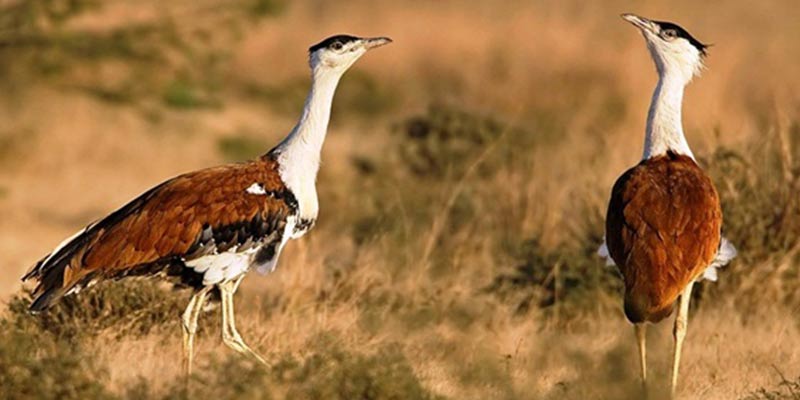- India
- Feb 06
Explainer / Protection of Great Indian Bustards
• A committee constituted by the Supreme Court on saving the Great Indian Bustard (GIB) has urged the apex court to pass directions for expediting underground laying of power transmission lines in priority and potential GIB habitats in Rajasthan and Gujarat.
• The Supreme Court, which is hearing a PIL on saving the Great Indian Bustard, had earlier directed the governments of Gujarat and Rajasthan to replace overhead electric cables with underground power cables, wherever feasible, and install bird diverters in priority areas where the birds live.
• While hearing the matter on November 30, 2022, the Supreme Court had mooted the idea of launching ‘Project GIB’ on the lines of ‘Project Tiger’, and sought the government’s view on the proposal.
Great Indian Bustard
• The Great Indian Bustard (Ardeotis nigriceps) is a critically endangered species with a small population of about 100–150 individuals that is largely restricted to Thar desert in Rajasthan.
• The population in India is currently facing high mortality due to bird collisions with power-lines along with habitat loss. The species has a slow life-history and cannot sustain any additional human induced mortality.
• Historically, the species was distributed throughout the western half of India, from Punjab and Haryana in north to Tamil Nadu in south, and from Gujarat and Rajasthan in west to Odisha in east, spanning eleven states along with eastern Pakistan in Cholistan and Sindh regions.
• The species distribution has currently reduced by 90 per cent from its former range.
• As per the studies conducted by Wildlife Institute of India, there are around 150 Great Indian Bustards left across the country which includes about 128 birds in Rajasthan and less than 10 birds each in states of Gujarat, Maharashtra, Andhra Pradesh and Karnataka.
Threats due to power lines
• The Wildlife Institute of India (WII) in its Report “Power Line Mitigation, 2018” has stated that every year one lakh birds die due to collision with power lines.
• Overhead power lines are the biggest threat to the survival of the GIBs.
• The Report concluded that unless power line mortality is mitigated urgently, extinction of GIBs is certain.
• The Great Indian Bustard is one of the heaviest flying birds in the world, about a metre in height and wingspan of around seven feet.
• The Great Indian Bustard lacks frontal vision. Due to this, they cannot detect power lines ahead of them, from far. As they are heavy birds, they are unable to manoeuvre across power lines within close distances. Thus, they are vulnerable to collision with power lines.
• In case of low voltage lines, electrocution is often the cause of death due to smaller phase to phase separation distance.
Steps taken by govt for protection of GIBs
• The Great Indian Bustard is listed in Schedule-I of the Wild Life (Protection) Act, 1972, thereby, according it highest degree of legal protection from hunting.
• Important habitats of GIBs are designated as national parks/sanctuaries for their better protection.
• The species has been identified for conservation efforts under the component ‘Species Recovery Programme’ of the Centrally Sponsored Scheme (CSS)-Development of Wildlife Habitat. Financial and technical assistance is provided to state/Union Territory governments under the Centrally Sponsored Scheme of Development of Wildlife Habitat for providing better protection to Great Indian Bustard and its habitat.
• The ministry of environment, forest and climate change has taken up an initiative on conservation breeding of the Great Indian Bustard in collaboration with Rajasthan, Gujarat and Maharashtra forest departments and technical support from Wildlife Institute of India, Dehradun.
• Great Indian Bustard has been included in the Appendix I of Convention on Migratory Species (CMS) on the basis of a proposal submitted by India.
• A site for establishment of a Conservation Breeding Centre for the Great Indian Bustard has been identified at Kota District, Rajasthan in consultations with State Forest Departments of Rajasthan and Gujarat, Wildlife Institute of India and international experts, under the project titled ‘Habitat Improvement and Conservation Breeding of Great Indian Bustard-an integrated approach’.
Manorama Yearbook app is now available on Google Play Store and iOS App Store

